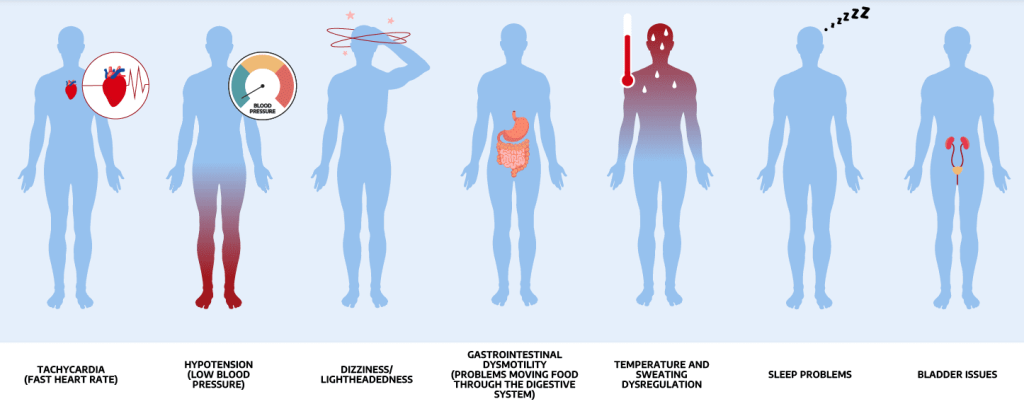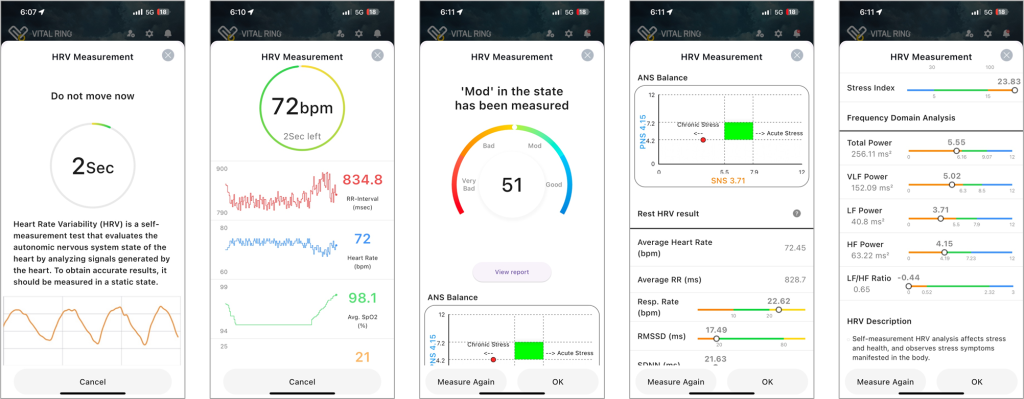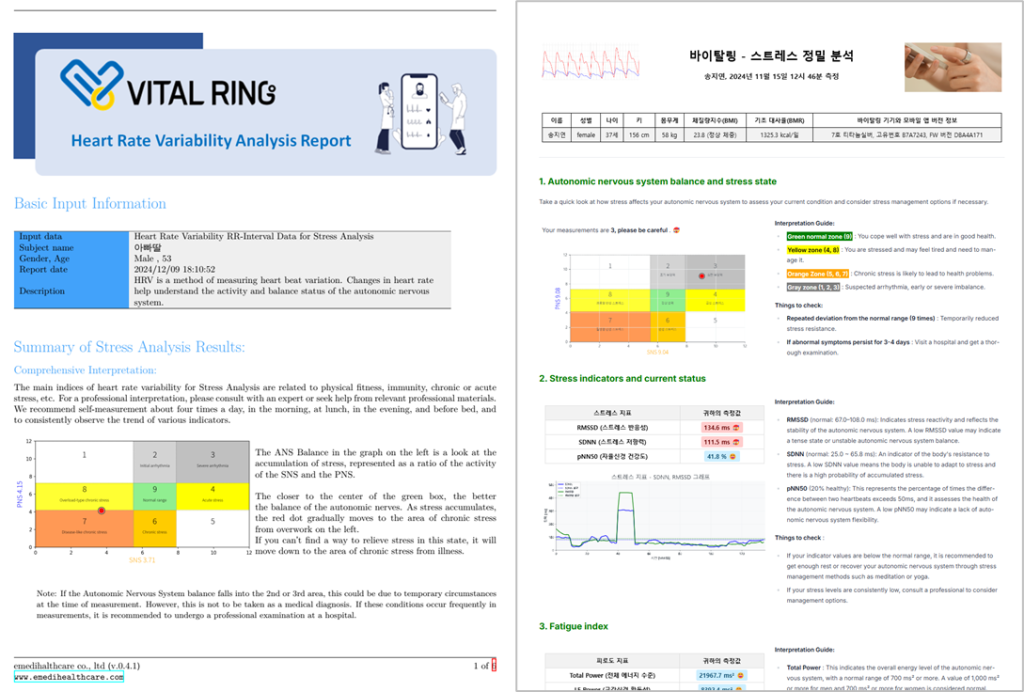Checking Autonomic Nervous System (ANS) Balance with Vital Ring®
Modern Approaches to Managing Stress and HRV (Heart Rate Variability)
The Stress of Modern Life: What We Need to Know
In today’s society, 95% of people experience stress. Stress doesn’t just affect our emotions but can have a serious impact on our physical health as well. Even during enjoyable activities, stress can be present. Effectively managing stress is essential for maintaining overall health and well-being.

Autonomic Nervous System Stress Test and HRV (Heart Rate Variability)
HRV (Heart Rate Variability) is a crucial indicator for measuring the balance of the autonomic nervous system (ANS). Stress can disrupt this balance, leading to long-term health issues. Regular HRV measurements allow us to understand the state of our autonomic nervous system and take practical steps to maintain good health.
What Does HRV Measure?
HRV measures the variation in time intervals between heartbeats. This metric reflects the balance of the autonomic nervous system (ANS), including the sympathetic nervous system (SNS) and the parasympathetic nervous system (PNS). It plays an important role in evaluating stress, recovery, and overall health.
Low HRV is linked to the sympathetic nervous system (responsible for stress response and arousal), suggesting fatigue, increased stress, or potential health issues.
High HRV is associated with the activation of the parasympathetic nervous system (responsible for rest and recovery), indicating effective stress management and recovery.

What HRV Can Tell You:
- Stress and recovery status
- Functionality of the autonomic nervous system
- Cardiovascular health and fatigue levels
HRV can also monitor the effectiveness of lifestyle changes such as exercise, sleep, and stress management.
Vital Ring®: Korea’s First AI-Based Stress Analysis Device
Vital Ring® analyzes your autonomic nervous system (ANS) through heart rate variability (HRV). This lightweight wearable device (2.8g) allows you to measure stress and recovery status anytime, anywhere.
Key Features:
- AI-based analysis: Provides highly accurate stress measurement and professional-grade reports.
- ANS balance assessment: Recommends optimal rest timing and strategies based on HRV.
- Ease of use: Comfortable, lightweight design that provides reliable data for daily use.

Unique Advantages:
- Precise stress measurement: Uses AI technology for detailed analysis.
- Professional reports: Offers deep insights into your health status.
- Convenient daily use: Measure HRV in just 2 minutes to effectively manage your mind and body.
What Is the Autonomic Nervous System (ANS)?
The autonomic nervous system (ANS) automatically controls essential body functions such as heart rate, blood pressure, digestion, and breathing. It consists of two main components:

- Sympathetic Nervous System (SNS): Manages the “fight or flight” response, increasing heart rate and providing quick energy.
- Parasympathetic Nervous System (PNS): Helps the body recover and stabilize, lowering heart rate and supporting restorative processes like digestion.
Maintaining a balanced ANS allows the body to effectively manage stress and improve resilience. Understanding this balance is the first step toward better heart health and overall well-being.

Symptoms of ANS Imbalance
When the autonomic nervous system is out of balance, you may experience symptoms such as:
- Chronic fatigue or lethargy
- Digestive issues and appetite changes
- Sleep disturbances (insomnia or excessive sleepiness)
- Frequent headaches or migraines
- Irregular heart rate or blood pressure
- Cold or tingling hands and feet
- Excessive sweating or reduced sweat production
If these symptoms persist, consult a healthcare professional for further evaluation.

“Autonomic Nervous System and HRV,” Journal of Clinical Cardiology (2022)
Monitoring HRV with Vital Ring®
ZTACom’s Vital Ring® is a wearable device equipped with advanced biosignal sensors that can track various health data. By measuring heart rate variability (HRV) continuously for 2 minutes, Vital Ring® helps users self-check the following indicators:
- Possibility of autonomic nervous system imbalance: Analyzes the balance between the sympathetic and parasympathetic nervous systems to evaluate stress and recovery status.
- Heart health status: Monitors heart rate variability and stability based on HRV data.
- Stress level: Tracks real-time stress levels and provides suggestions for relief when needed.
Through these features, Vital Ring® enables users to understand their health condition and take practical steps toward improvement.

Below is an example of a Heart Rate Variability (HRV) Stress Analysis Report:

1. ANS Balance and Stress Status
The ANS balance report analyzes the activity ratio between the sympathetic nervous system (SNS) and the parasympathetic nervous system (PNS) to evaluate your stress and recovery status. The SNS is responsible for immediate stress responses, while the PNS is involved in recovery and rest. The Vital Ring® HRV Analysis Report visually displays your ANS balance to help you maintain an appropriate ratio of stress and recovery.

Interpretation Guide:
- Green (Normal Zone, Zone 9): You are handling stress well and are in good health.
- Yellow (Zone 4, 8): Accumulated stress. You may feel fatigued and require some management.
- Orange (Zone 5, 6, 7): Chronic stress is worsening, potentially leading to health issues.
- Gray (Zone 1, 2, 3): Suspected arrhythmia or initial/serious ANS imbalance.
Checkpoints:
- If you repeatedly leave the normal range (Zone 9), your stress resistance may be temporarily low.
- If abnormal signs persist for 3–4 days, visit a hospital for a detailed evaluation.
2. Stress Indicators and Current Status
| Stress Indicators | Your Data (Example) |
|---|---|
| RMSSD (Stress Responsiveness) | 27.8 ms 😄 |
| SDNN (Stress Resistance) | 24.6 ms 🥵 |
| pNN50 (ANS Health) | 9.3 % 🥵 |

Interpretation Guide:
- RMSSD (Normal: 25.9–58.1 ms): Reflects stress responsiveness and the stability of the ANS. A low value suggests a tense state or unstable ANS balance.
- SDNN (Normal: 27.8–61.4 ms): Represents your body’s resistance to stress. A low SDNN indicates poor adaptation to stress and accumulated tension.
- pNN50 (Healthy: >20%): The percentage of successive heartbeats with a time difference exceeding 50 ms. A low value indicates reduced ANS flexibility.
Checkpoints:
- If values are below the normal range, prioritize rest or engage in stress management techniques such as meditation or yoga to recover your ANS.
- If stress indicators remain persistently low, consult a specialist to explore further management options.
3. Fatigue Indicators
The fatigue indicators are derived from HRV and heart rate data to measure your physical fatigue level. High fatigue indicates insufficient recovery, potentially leading to chronic fatigue and increased stress. Vital Ring® visualizes this data, enabling better understanding and appropriate rest.
| Fatigue Indicators | Your Data (Example) |
|---|---|
| Total Power (Overall Energy Level) | 590.6 ms² 🥵 |
| LF Power (SNS Activity) | 507.8 ms² 😄 |
| HF Power (PNS Activity) | 69.2 ms² 🥵 |
| LF/HF Ratio (SNS-PNS Balance) | 7.34 😄 |

Interpretation Guide:
- Total Power (Normal: >1000 ms²): Represents overall ANS energy levels. Values below normal suggest reduced ANS function.
- Normal: >1000 ms² for men, >700 ms² for women.
- LF Power (Normal: >300 ms²): Reflects SNS activity. Low values may indicate accumulated fatigue and stress.
- HF Power (Normal: >400 ms²): Represents PNS activity and recovery ability. Low values suggest tension and insufficient rest.
- LF/HF Ratio (Normal: 0.11–7.35): Indicates the balance between SNS and PNS. Deviating from this range suggests persistent stress or tension.
Checkpoints:
- If values are below normal, it could indicate accumulated fatigue. Ensure adequate rest, hydration, and remeasure after sleep.
- If Total Power and LF Power remain low for 3–4 days, consult a specialist for further evaluation.
4. Heart Rate Variability (HRV) Indicators
HRV indicators analyze the variation in time intervals between heartbeats to assess your stress responsiveness and heart rate stability. High variability indicates flexibility in adapting to various situations, while low variability suggests stress or potential health deterioration.

Interpretation Guide:
- Normal (High Variability): Your ANS is responding flexibly, with strong stress resilience.
- Abnormal (Low Variability): Reduced ANS flexibility, potentially due to accumulated stress or health issues.

Checkpoints:
- If abnormalities persist, ensure rest and stability before remeasuring.
- If no improvement occurs, consult a specialist to evaluate HRV further and establish a management plan.
“HRV Trends in Stress Assessment,” Cardiovascular Medicine Journal (2020)
5. Heart Rate Indicators: Assessing Cardiac Activity
Heart rate indicators assess cardiac activity based on beats per minute (BPM). Vital Ring® monitors this data in real time, helping you manage exercise, rest, and stress effectively.

Interpretation Guide:
- Green (Normal): Within the normal heart rate range for your age.
- Orange (Attention): Slightly elevated heart rate; management may be needed.
- Red (Caution): Elevated heart rate that could impact long-term health.

Checkpoints:
- For attention or caution ranges, engaging in exercise may help lower heart rate.
- If elevated heart rates persist, consult a specialist for further examination, including arrhythmia tests.
- Maintain a healthy heart rate through regular exercise, proper rest, and stress management.
6. Distribution Indicators: Stress and Heart Health Status
Distribution indicators visualize your heart rate and HRV data using histograms or heatmaps to evaluate stress and heart health status. They help detect abnormal patterns and guide plans to maintain healthy cardiac activity.

Interpretation Guide:
- Wide Distribution (Normal): Indicates flexibility in ANS response to stress, with good heart health.
- Narrow Distribution (Abnormal): Suggests high stress or reduced heart health.

Checkpoints:
- If abnormal states persist, actively manage stress using relaxation techniques. Seek professional guidance if needed.
- Adopt stress-relief habits and a healthy lifestyle to maintain a stable and wide distribution.
“Visualizing Heart Rate Variability,” Data Science in Medicine (2019)
7. HRV Analysis: Stress and Heart Health Status
HRV measures the variability in time intervals between heartbeats, directly reflecting stress and heart health. The Vital Ring® report evaluates HRV through both time-domain metrics (e.g., RMSSD, SDNN) and frequency-domain metrics (e.g., LF, HF).

Interpretation Guide:
- Normal (Elliptical, Wide Distribution): Indicates stable ANS function with good stress resilience and heart health.
- Abnormal (Circular, Narrow Distribution): Reduced ANS flexibility, high stress, or potential heart health issues.

Checkpoints:
- If abnormal states persist, rest and attempt stress management techniques. If no improvement occurs, seek detailed medical evaluation.
- Maintain ANS health through regular exercise, meditation, and good sleep hygiene.
Stress Risk Factors and Prevention
Risk Factors
- Chronic Stress: Prolonged stress can decrease HRV and negatively impact heart health.
- Irregular Sleep: Poor or insufficient sleep disrupts the balance of the autonomic nervous system.
- Sedentary Lifestyle: Lack of physical activity negatively affects HRV and overall health.
- Smoking and Excessive Alcohol Consumption: These habits lower HRV and worsen heart health.
Prevention Methods
- Regular Exercise: Consistent physical activity, such as aerobic exercise, helps improve HRV.
- Sleep Management: Maintain a regular sleep schedule and create an environment conducive to deep sleep.
- Stress Management: Practice relaxation techniques such as meditation, deep breathing, or yoga.
- Healthy Diet: A balanced diet supports overall well-being and autonomic nervous system health.
- Lifestyle Improvements: Quitting smoking and reducing alcohol consumption are key to enhancing HRV.
Important Note:
Vital Ring® is not a medical device and is not intended to diagnose, treat, cure, monitor, or prevent any medical conditions. For an official diagnosis, consult a professional healthcare provider.
Conclusion
Vital Ring® provides an effective way to monitor stress and recovery status using HRV, offering valuable insights to help improve your overall health. However, it is important to remember that final diagnoses and treatments should be conducted by professional medical institutions. By consistently tracking your health and seeking guidance from experts, you can take proactive steps to maintain a healthy and balanced life.
Sources
- “Autonomic Nervous System and HRV,” Journal of Clinical Cardiology (2022): https://www.journalofclinicalcardiology.com/hrv-autonomic
- “HRV Metrics for Stress Monitoring,” Biomedical Engineering Reviews (2021): https://www.biomedicalreviews.org/hrv-metrics
- “HRV Trends in Stress Assessment,” Cardiovascular Medicine Journal (2020): https://www.cardiovascularjournal.com/hrv-trends
- “Visualizing Heart Rate Variability,” Data Science in Medicine (2019): https://www.datasciencemedicine.org/hrv-visualization
